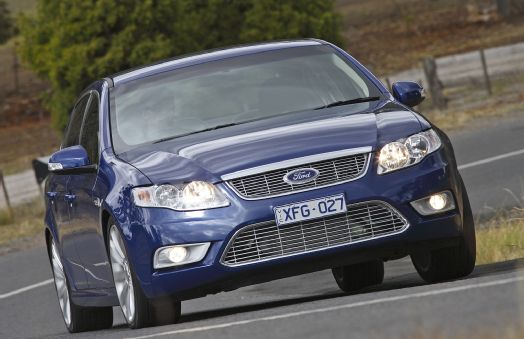Ford to End Australian Manufacturing in 2016

Ford to End Australian Manufacturing in 2016
What Does it Mean for Us?
By Scott Evans | July 18, 2013
Find more articles and research about Ford cars.
Ford fans and performance enthusiasts have been pining for Australian muscle sedans such as the Ford Falcon and Holden Commodore for years. While Holden fans got a taste with the short-lived Pontiac G8 and are primed for the new Chevrolet SS, Ford fans have never been able to say the same, and now they never will. Ford announced it will end local manufacturing in Australia in 2016, which means the end of the single-market Falcon as well as the Falcon Ute pickup variant and the Territory SUV.
There are a number of reasons behind Ford’s decision, but they all come back to money. Ford’s two Australian plants, Broadmeadows (assembly) and Geelong (stampings), have lost the equivalent of $583 million (all denominations in this story are in U.S. dollars) over the past five years, while Ford Australia lost $455 million in the last two years alone. The company tried to stem the bleeding by reducing production from 209 vehicles per day to 148, but with Falcon sales cratering from a high of more than 80,000 annually 20 years ago to less than 20,000 today, there was little hope. Falcon sales are at their lowest point since the factory opened in 1960.
The sales decline can be attributed to a number of things. Gasoline prices in Australia have climbed steadily over the past decade and average $1.30 per liter, or $4.93 per gallon. Meanwhile, the Australian dollar has appreciated significantly, tariffs on imported automobiles have fallen by half, and free trade agreements have proliferated, abolishing some tariffs entirely. This has led to a massive increase in competition with more than 65 brands and 365 models competing in a market that only sells 1.1 million cars per year, compared with the more than 14 million per year sold in America. Where big Holdens and Fords used to rule, sales charts are now dominated by imported small cars such as the Mazda3, Toyota Corolla, and Hyundai i30 (Elantra Touring). So far this year, the Holden Commodore is ninth in sales and the Falcon is 37th. Where the Commodore and Falcon used to hold a combined 22 percent of the Australian market 20 years ago, today the two account for just 4 percent of total sales.
In announcing the decision, Ford assured customers it has explored all options to maintain local production including exports, cost reductions, improvements in production efficiency, new models, and government support, but found no viable solution.
“Given the fragmented marketplace and the low model volumes that result, we decided that manufacturing locally is no longer viable,” said Bob Graziano, Ford Australia president and CEO.
“Despite our efforts,” Graziano told a press conference, “locally made products continue to be unprofitable while internationally made products are profitable. Costs are double those in Europe and four times those in Asia. This means conditions are not viable for production in Australia any longer.”
Ford tried to put a positive spin on things, promising to release new versions of the Falcon, Falcon Ute, and Territory for 2014, and to expand its Australian lineup by 30 percent with imported models such as the Kuga (Escape) and Mondeo (Fusion). Ford also assured Australia that it would provide the 1600 employees of the two shuttered plants with all the benefits guaranteed them under current contracts and will work with them over the next three years to prepare for the shutdown.
The plant closures don’t mean that Ford is abandoning Australia, however. Ford lists Australia as one of four global product development hubs, and the country has recently been responsible for the global Ranger and Figo. The product development center will remain open and its 1000 employees, as well as 500 other Ford Australia corporate staff, will keep their jobs. The company’s more than 200 dealers nationwide will no doubt be affected by the loss of three important products, but it’s impossible to say if that will force any to close.
The closures met with heavy blowback from Australian citizens. Ford and Holden together have received more than $11.6 billion in taxpayer-funded subsidies from the Australian government over the past decade, according to The Australian. Last year, Ford Australia received more than $100 million in total funding from Ford Motor Company and from the Australian government. Worries about a shutdown flared earlier this year when Ford failed to request government support for manufacturing beyond 2016.
The Ford Falcon, meanwhile, is something of an icon in Australia. It and its competitor, the Commodore, were the respective flagships of Ford and Holden and have been on sale for generations. Unlike the Commodore, though, the Falcon was never adapted to left-hand drive and never sold outside of Australia. As such, it didn’t fit into the “One Ford” global product plan. Ford CEO Alan Mulally said as much earlier this year, noting that the days of “one-off cars for one-off countries” are over. Re-engineering the Falcon for right-hand drive and international crash and emissions standards would be too costly given its low sales volumes. There’s no telling yet how the loss of the Falcon will affect its long-standing Holden rival, be it ceding market share or spurring GM to follow suit. Either way, the legendary rivalry, both on the road and in the V8 Supercars race series, is over.
Holden, for one, is downplaying any impact from Ford’s decision. Said chairman and managing director Mike Devereux in a statement: “Despite Ford’s announcement to end local manufacturing, we believe the industry can survive in Australia and has already adjusted in large part given Ford’s relatively low production volumes.”
Devereux reminds us that in 2012 Holden laid out a 10-year manufacturing plan with the help of the Australian government that calls for an investment of a billion Australian dollars and the addition of two all-new global models to Australian production lines. He also tells The Australian that Holden is working with the government to set policy that will keep local production competitive globally.
The death of the Falcon and Ford’s Australian manufacturing plants has broader implications. For Ford, it means the company will be left with only one rear-wheel-drive car platform, the Mustang. While that car will soon be sold in international markets, it’s still a unique platform serving a single model, the antithesis of modern auto manufacturing strategy. It remains to be seen whether the updated 2015 Mustang platform has the bandwidth necessary to underpin other vehicles, such as a long-rumored but never-confirmed Lincoln coupe or sedan.
Outside Ford, the decision could seriously rattle both the Australian and global auto industries. The loss of Ford manufacturing could seriously hurt Tier 1 and Tier 2 suppliers in Australia, and that could be bad news for Holden and Toyota, which are maintaining their Australian manufacturing for now. Should suppliers fail in the wake of Ford’s closures, the pain could spread beyond Toyota and GM to any other manufacturers that did business with those suppliers. Thankfully, everyone involved has three years to come up with new business plans. The financial effect on V8 Supercars is likewise unknown, though the series has been proactive about bringing in new competitors such as Nissan and Mercedes-Benz.
Former Ford CEO Jac Nasser predicted in April that the end was nigh for automobile manufacturing in Australia.
“The signs aren’t good,” he told The Australian. “You’ve got an exchange rate at a 30-year high, you’ve got higher costs in Australia, you’ve got excess capacity in the motor industry worldwide, you’ve got a very weak currency in Japan, and you’ve got a weak Euro. When you put that mix together, it’s very difficult to expect a relatively small but talented Australian auto industry to work its way.”
He was right in regard to Ford, and the rest of his prediction seems prescient. Nasser continued: “As soon as you have a reduction in the scale of domestic manufacturing — let’s assume one of the three decide to exit Australia in terms of manufacturing — then you end up potentially with sub-scale supplier infrastructure. Once that happens, I think it’s a domino effect. It would be a very sad day for Australia, but unfortunately, it looks like it could be inevitable.”
Celebrity Drive: Far East Movement’s DJ Virman







